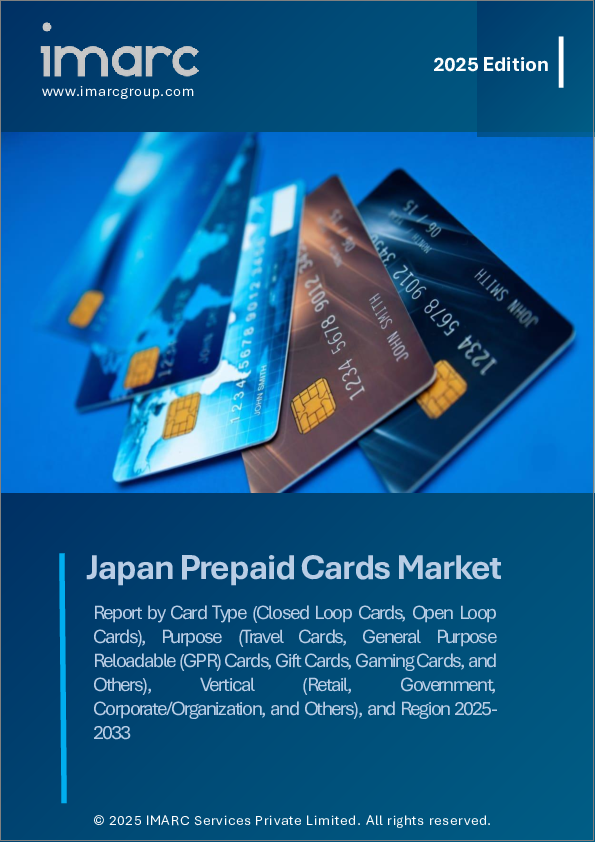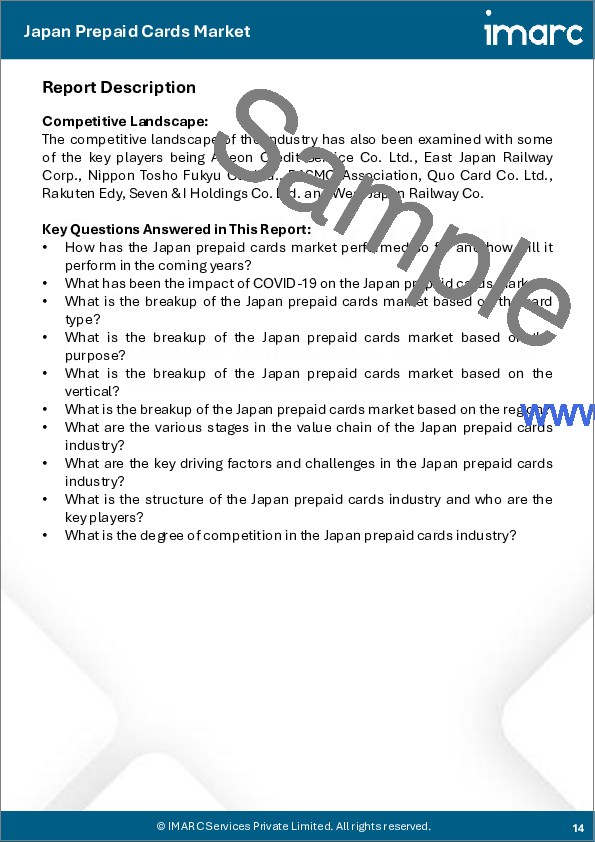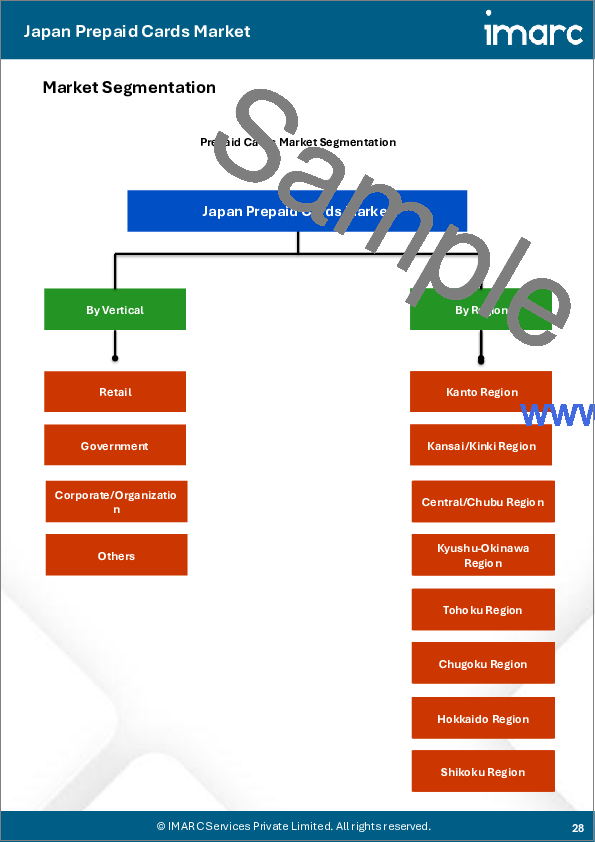|
|
市場調査レポート
商品コード
1792440
日本のプリペイドカード市場レポート:カードタイプ別、目的別、産業別、地域別、2025~2033年Japan Prepaid Cards Market Report by Card Type, Purpose (Travel Cards, General Purpose Reloadable Cards, Gift Cards, Gaming Cards, and Others), Vertical, and Region 2025-2033 |
||||||
カスタマイズ可能
|
|||||||
| 日本のプリペイドカード市場レポート:カードタイプ別、目的別、産業別、地域別、2025~2033年 |
|
出版日: 2025年08月01日
発行: IMARC
ページ情報: 英文 115 Pages
納期: 2~3営業日
|
全表示
- 概要
- 図表
- 目次
日本のプリペイドカード市場規模は2024年に1,274億米ドルに達しました。今後、IMARC Groupは、2033年には5,106億米ドルに達し、2025~2033年の成長率(CAGR)は15.8%になると予測しています。
プリペイドカードは、あらかじめ現金残高が入金されている決済カードであり、現金決済の代替として使用されます。これらのカードは、銀行への預金口座の開設や貸出口座の開設を必要としないです。プリペイドカードの中には、ギフトカードのようにリロードできないものもあります。一方、リロード可能なプリペイドカードは、繰り返し資金を補充することができます。
日本のeコマース市場は世界第4位であり、急速に成長しているため、プリペイドカードを使用してオンライン決済を行う消費者が増えています。さらに、ハイパーマーケット、スーパーマーケット、コンビニエンスストアなどの近代的な小売施設では、プリペイドカードを利用したロイヤルティプログラムやリワードスキームが提供されており、キャッシュレス決済への動機付けとなっています。これに加えて、プリペイドカードは、リテール決済との緊密な連携、プリペイド交通乗車券のような非接触交通商品など、日本における様々なマイクロペイメントにも使用されています。その結果、加盟店はクローズドループのプリペイドカードを空港、自動販売機、高速道路のサービスステーションなどの他のネットワークに拡大する方法も模索しています。また、2020年の東京オリンピック・パラリンピック開催を控え、官民一体となったキャッシュレス化がプリペイドカード市場を牽引することが期待されています。
IMARC Groupの最新レポートでは、日本のプリペイドカード市場について、その重要な側面すべてを網羅した深い洞察を提供しています。その内容は、市場のマクロな概要から、産業実績のミクロな詳細、最近の動向、市場促進要因・課題、SWOT分析、ポーターのファイブフォース分析、バリューチェーン分析など多岐にわたります。本レポートは、起業家、投資家、研究者、コンサルタント、ビジネス戦略家、何らかの形で日本のプリペイドカード市場に関わる、または参入を計画しているすべての方々にとって必読の書です。
本レポートで扱う主要質問
- 日本のプリペイドカード市場はこれまでどのように推移し、今後どのように推移するのか?
- COVID-19が日本のプリペイドカード市場に与えた影響は?
- 日本のプリペイドカード市場のカードタイプ別区分は?
- 日本のプリペイドカード市場の目的別区分は?
- 日本のプリペイドカード市場の産業区分による内訳は?
- 日本のプリペイドカード市場の地域別区分は?
- 日本のプリペイドカード産業のバリューチェーンにおける様々なステージとは?
- 日本のプリペイドカード産業の主要な促進要因と課題は何か?
- 日本のプリペイドカード産業の構造と主要参入企業は?
- 日本のプリペイドカード産業における競合の程度は?
目次
第1章 序文
第2章 調査範囲と調査手法
- 調査の目的
- ステークホルダー
- データソース
- 一次情報
- 二次情報
- 市場推定
- ボトムアップアプローチ
- トップダウンアプローチ
- 調査手法
第3章 エグゼクティブサマリー
第4章 イントロダクション
- 概要
- 主要産業動向
第5章 プリペイドカード市場
- 市場概要
- 市場実績
- COVID-19の影響
- 市場予測
- SWOT分析
- バリューチェーン分析
- ポーターのファイブフォース分析
- 主要成功要因とリスク要因
第6章 市場内訳:カードタイプ別
- クローズドループカード
- オープンループカード
第7章 市場内訳:目的別
- トラベルカード
- 汎用リロード可能(GPR)カード
- ギフトカード
- ゲームカード
- その他
第8章 市場内訳:産業別
- 小売
- 政府
- 企業/組織
- その他
第9章 市場内訳:地域別
- 関東地方
- 関西地方
- 中部地方
- 九州・沖縄地方
- 東北地方
- 中国地方
- 北海道地方
- 四国地方
第10章 競合情勢
- 市場構造
- 主要企業
- 主要企業のプロファイル
- Rakuten Edy
- Quo Card Co Ltd.
- PASMO Association
- Aeon Credit Service Co Ltd.
- West Japan Railway Co.
- East Japan Railway Corp.
- Seven & I Holdings Co Ltd.
- Nippon Tosho Fukyu Co Ltd.
List of Figures
- Figure 1: Japan: Prepaid Cards Market: Major Drivers and Challenges
- Figure 2: Japan: Prepaid Cards Market: Value Trends (in Billion USD), 2019-2024
- Figure 3: Japan: Prepaid Cards Market Forecast: Value Trends (in Billion USD), 2025-2033
- Figure 4: Japan: Prepaid Cards Market: Breakup by Card Type (in %), 2024
- Figure 5: Japan: Prepaid Cards Market: Breakup by Purpose (in %), 2024
- Figure 6: Japan: Prepaid Cards Market: Breakup by Vertical (in %), 2024
- Figure 7: Japan: Prepaid Cards Market: Breakup by Region (in %), 2024
- Figure 8: Japan: Prepaid Cards Industry: SWOT Analysis
- Figure 9: Japan: Prepaid Cards Industry: Value Chain Analysis
- Figure 10: Japan: Prepaid Cards Industry: Porter's Five Forces Analysis
- Figure 11: Japan: Prepaid Cards Market (Closed Loop Cards): Value Trends (in Billion USD), 2019 & 2024
- Figure 12: Japan: Prepaid Cards Market Forecast (Closed Loop Cards): Value Trends (in Billion USD), 2025-2033
- Figure 13: Japan: Prepaid Cards Market (Open Loop Cards): Value Trends (in Billion USD), 2019 & 2024
- Figure 14: Japan: Prepaid Cards Market Forecast (Open Loop Cards): Value Trends (in Billion USD), 2025-2033
- Figure 15: Japan: Prepaid Cards Market (Travel Cards): Value Trends (in Billion USD), 2019 & 2024
- Figure 16: Japan: Prepaid Cards Market Forecast (Travel Cards): Value Trends (in Billion USD), 2025-2033
- Figure 17: Japan: Prepaid Cards Market (General Purpose Reloadable Cards): Value Trends (in Billion USD), 2019 & 2024
- Figure 18: Japan: Prepaid Cards Market Forecast (General Purpose Reloadable Cards): Value Trends (in Billion USD), 2025-2033
- Figure 19: Japan: Prepaid Cards Market (Gift Cards): Value Trends (in Billion USD), 2019 & 2024
- Figure 20: Japan: Prepaid Cards Market Forecast (Gift Cards): Value Trends (in Billion USD), 2025-2033
- Figure 21: Japan: Prepaid Cards Market (Gaming Cards): Value Trends (in Billion USD), 2019 & 2024
- Figure 22: Japan: Prepaid Cards Market Forecast (Gaming Cards): Value Trends (in Billion USD), 2025-2033
- Figure 23: Japan: Prepaid Cards Market (Other Purpose Cards): Value Trends (in Billion USD), 2019 & 2024
- Figure 24: Japan: Prepaid Cards Market Forecast (Other Purpose Cards): Value Trends (in Billion USD), 2025-2033
- Figure 25: Japan: Prepaid Cards Market (Retail): Value Trends (in Billion USD), 2019 & 2024
- Figure 26: Japan: Prepaid Cards Market Forecast (Retail): Value Trends (in Billion USD), 2025-2033
- Figure 27: Japan: Prepaid Cards Market (Government): Value Trends (in Billion USD), 2019 & 2024
- Figure 28: Japan: Prepaid Cards Market Forecast (Government): Value Trends (in Billion USD), 2025-2033
- Figure 29: Japan: Prepaid Cards Market (Corporate/Organization): Value Trends (in Billion USD), 2019 & 2024
- Figure 30: Japan: Prepaid Cards Market Forecast (Corporate/Organization): Value Trends (in Billion USD), 2025-2033
- Figure 31: Japan: Prepaid Cards Market (Others): Value Trends (in Billion USD), 2019 & 2024
- Figure 32: Japan: Prepaid Cards Market Forecast (Others): Value Trends (in Billion USD), 2025-2033
- Figure 33: Kanto Region: Prepaid Cards Market: Value Trends (in Billion USD), 2019 & 2024
- Figure 34: Kanto Region: Prepaid Cards Market Forecast: Value Trends (in Billion USD), 2025-2033
- Figure 35: Kinki Region: Prepaid Cards Market: Value Trends (in Billion USD), 2019 & 2024
- Figure 36: Kinki Region: Prepaid Cards Market Forecast: Value Trends (in Billion USD), 2025-2033
- Figure 37: Central/Chubu Region: Prepaid Cards Market: Value Trends (in Billion USD), 2019 & 2024
- Figure 38: Central/Chubu Region: Prepaid Cards Market Forecast: Value Trends (in Billion USD), 2025-2033
- Figure 39: Kyushu-Okinawa Region: Prepaid Cards Market: Value Trends (in Billion USD), 2019 & 2024
- Figure 40: Kyushu-Okinawa Region: Prepaid Cards Market Forecast: Value Trends (in Billion USD), 2025-2033
- Figure 41: Tohoku Region: Prepaid Cards Market: Value Trends (in Billion USD), 2019 & 2024
- Figure 42: Tohoku Region: Prepaid Cards Market Forecast: Value Trends (in Billion USD), 2025-2033
- Figure 43: Chugoku Region: Prepaid Cards Market: Value Trends (in Billion USD), 2019 & 2024
- Figure 44: Chugoku Region: Prepaid Cards Market Forecast: Value Trends (in Billion USD), 2025-2033
- Figure 45: Hokkaido Region: Prepaid Cards Market: Value Trends (in Billion USD), 2019 & 2024
- Figure 46: Hokkaido Region: Prepaid Cards Market Forecast: Value Trends (in Billion USD), 2025-2033
- Figure 47: Shikoku Region: Prepaid Cards Market: Value Trends (in Billion USD), 2019 & 2024
- Figure 48: Shikoku Region: Prepaid Cards Market Forecast: Value Trends (in Billion USD), 2025-2033
List of Tables
- Table 1: Japan: Prepaid Cards Market: Key Industry Highlights, 2024 and 2033
- Table 2: Japan: Prepaid Cards Market Forecast: Breakup by Card Type (in Billion USD), 2025-2033
- Table 3: Japan: Prepaid Cards Market Forecast: Breakup by Purpose (in Billion USD), 2025-2033
- Table 4: Japan: Prepaid Cards Market Forecast: Breakup by Vertical (in Billion USD), 2025-2033
- Table 5: Japan: Prepaid Cards Market Forecast: Breakup by Region (in Billion USD), 2025-2033
- Table 6: Japan: Prepaid Cards Market Structure
- Table 7: Japan: Prepaid Cards Market: Key Players
The Japan prepaid cards market size reached USD 127.4 Billion in 2024. Looking forward, IMARC Group expects the market to reach USD 510.6 Billion by 2033, exhibiting a growth rate (CAGR) of 15.8% during 2025-2033.
Prepaid card is a payment card which has previously deposited cash balance and is used as an alternative of cash payment. These cards do not require opening of a direct deposit or lending account with a bank. Some prepaid cards are not reloadable, such as gift cards. On the other hand, reloadable prepaid cards can be replenished with funds repeatedly.
The Japan's e-commerce market is the fourth largest in the world and is growing at a fast rate, thereby indulging a greater number of consumers making online payments using prepaid cards. Moreover, modern retail facilities such as hypermarkets, supermarkets, convenience stores, etc., offer loyalty programs and reward schemes with prepaid cards that motivate the customers to gravitate toward cashless payment in the country. In addition to this, prepaid cards are also used for the various micropayments in Japan such as tight linkage with retail payments, contactless transport products like prepaid transport ticketing, etc. As a result, merchants are also looking for ways to expand their closed-loop prepaid cards to other networks such as airports, vending machines and highway service stations, etc. Moreover, Japan is looking forward to host 2020 Tokyo Olympic and Paralympic Games, where united front between public and private sectors is anticipated to drive the prepaid cards market in order to promote a cashless environment.
IMARC Group's latest report provides a deep insight into the Japan prepaid cards market covering all its essential aspects. This ranges from macro overview of the market to micro details of the industry performance, recent trends, key market drivers and challenges, SWOT analysis, Porter's five forces analysis, value chain analysis, etc. This report is a must-read for entrepreneurs, investors, researchers, consultants, business strategists, and all those who have any kind of stake or are planning to foray into the Japan prepaid cards market in any manner.
Key Market Segmentation:
Breakup by Card Type:
- Closed Loop Cards
- Open Loop Cards
Breakup by Purpose:
- Travel Cards
- General Purpose Reloadable (GPR) Cards
- Gift Cards
- Gaming Cards
- Others
Breakup by Vertical:
- Retail
- Government
- Corporate/Organization
- Others
Breakup by Region:
- Kanto Region
- Kinki Region
- Central/ Chubu Region
- Kyushu-Okinawa Region
- Tohoku Region
- Chugoku Region
- Hokkaido Region
- Shikoku Region
Competitive Landscape:
The competitive landscape of the industry has also been examined with some of the key players being Aeon Credit Service Co. Ltd., East Japan Railway Corp., Nippon Tosho Fukyu Co. Ltd., PASMO Association, Quo Card Co. Ltd., Rakuten Edy, Seven & I Holdings Co. Ltd. and West Japan Railway Co.
Key Questions Answered in This Report:
- How has the Japan prepaid cards market performed so far and how will it perform in the coming years?
- What has been the impact of COVID-19 on the Japan prepaid cards market?
- What is the breakup of the Japan prepaid cards market based on the card type?
- What is the breakup of the Japan prepaid cards market based on the purpose?
- What is the breakup of the Japan prepaid cards market based on the vertical?
- What is the breakup of the Japan prepaid cards market based on the region?
- What are the various stages in the value chain of the Japan prepaid cards industry?
- What are the key driving factors and challenges in the Japan prepaid cards industry?
- What is the structure of the Japan prepaid cards industry and who are the key players?
- What is the degree of competition in the Japan prepaid cards industry?
Table of Contents
1 Preface
2 Scope and Methodology
- 2.1 Objectives of the Study
- 2.2 Stakeholders
- 2.3 Data Sources
- 2.3.1 Primary Sources
- 2.3.2 Secondary Sources
- 2.4 Market Estimation
- 2.4.1 Bottom-Up Approach
- 2.4.2 Top-Down Approach
- 2.5 Forecasting Methodology
3 Executive Summary
4 Introduction
- 4.1 Overview
- 4.2 Key Industry Trends
5 Japan Prepaid Cards Market
- 5.1 Market Overview
- 5.2 Market Performance
- 5.3 Impact of COVID-19
- 5.4 Market Forecast
- 5.5 SWOT Analysis
- 5.5.1 Overview
- 5.5.2 Strengths
- 5.5.3 Weaknesses
- 5.5.4 Opportunities
- 5.5.5 Threats
- 5.6 Value Chain Analysis
- 5.7 Porters Five Forces Analysis
- 5.7.1 Overview
- 5.7.2 Bargaining Power of Buyers
- 5.7.3 Bargaining Power of Suppliers
- 5.7.4 Degree of Competition
- 5.7.5 Threat of New Entrants
- 5.7.6 Threat of Substitutes
- 5.8 Key Success and Risk Factors
6 Market Breakup by Card Type
- 6.1 Closed Loop Cards
- 6.1.1 Market Trends
- 6.1.2 Market Forecast
- 6.2 Open Loop Cards
- 6.2.1 Market Trends
- 6.2.2 Market Forecast
7 Market Breakup by Purpose
- 7.1 Travel Cards
- 7.1.1 Market Trends
- 7.1.2 Market Forecast
- 7.2 General Purpose Reloadable (GPR) Cards
- 7.2.1 Market Trends
- 7.2.2 Market Forecast
- 7.3 Gift Cards
- 7.3.1 Market Trends
- 7.3.2 Market Forecast
- 7.4 Gaming Cards
- 7.4.1 Market Trends
- 7.4.2 Market Forecast
- 7.5 Others
- 7.5.1 Market Trends
- 7.5.2 Market Forecast
8 Market Breakup by Vertical
- 8.1 Retail
- 8.1.1 Market Trends
- 8.1.2 Market Forecast
- 8.2 Government
- 8.2.1 Market Trends
- 8.2.2 Market Forecast
- 8.3 Corporate/Organization
- 8.3.1 Market Trends
- 8.3.2 Market Forecast
- 8.4 Others
- 8.4.1 Market Trends
- 8.4.2 Market Forecast
9 Market Breakup by Region
- 9.1 Kanto Region
- 9.1.1 Market Trends
- 9.1.2 Market Forecast
- 9.2 Kinki Region
- 9.2.1 Market Trends
- 9.2.2 Market Forecast
- 9.3 Central/Chubu Region
- 9.3.1 Market Trends
- 9.3.2 Market Forecast
- 9.4 Kyushu-Okinawa Region
- 9.4.1 Market Trends
- 9.4.2 Market Forecast
- 9.5 Tohoku Region
- 9.5.1 Market Trends
- 9.5.2 Market Forecast
- 9.6 Chugoku Region
- 9.6.1 Market Trends
- 9.6.2 Market Forecast
- 9.7 Hokkaido Region
- 9.7.1 Market Trends
- 9.7.2 Market Forecast
- 9.8 Shikoku Region
- 9.8.1 Market Trends
- 9.8.2 Market Forecast
10 Competitive Landscape
- 10.1 Market Structure
- 10.2 Key Players
- 10.3 Profiles of Key Players
- 10.3.1 Rakuten Edy
- 10.3.2 Quo Card Co Ltd.
- 10.3.3 PASMO Association
- 10.3.4 Aeon Credit Service Co Ltd.
- 10.3.5 West Japan Railway Co.
- 10.3.6 East Japan Railway Corp.
- 10.3.7 Seven & I Holdings Co Ltd.
- 10.3.8 Nippon Tosho Fukyu Co Ltd.






